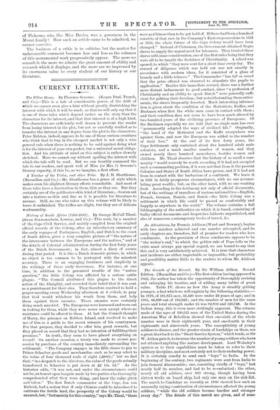The Growth of the Recruit. By Sir William Aitken. Second
Edition. (Macmillan and Co.)—The first edition having appeared in. 1862, the author has taken the opportunity of thoroughly revising and enlarging his treatise, and of adding many tables of great value. Table IV. shows us how the Army is steadily getting younger, a fact which we will explain by the following statistics :— In 1876, of 181,875 men, 56,420 were under 23 years of age ; and in 1885, 86,898 out of 192,929; and the number of men for the same years and total strength under 25 was 82,802 and 120,748. In the Indian Army, this is even more strikingly apparent. The returns made of the ages of 190,621 men of the United States during the American Wax of Rebellion showed that one-sixth of the whole number were in their eighteenth year, and one-fourth in their eighteenth and nineteenth years. The susceptibility of young soldiers to disease, and the greater strain of hardships on them, are a great drawback to the "Short-Service System," which tends, as Sir W. Aitken puts it, to increase the number of young soldiers who have not attained anything like mature development. Lord Wolseley's opinion as to their capabilities must be taken to refer to their military discipline, and most certainly not to their enduring power. It is certainly cruelty to send such " boys " to India. In the beginning of the century, two regiments were sent from India to join General Abercrombie; one, consisting chiefly of "boys," lost nearly half its number, and had to be re-embarked ; the other, nearly all old soldiers, over 900 strong, though having been sixteen weeks on board ship, had only one man on the sick-list. The march to Candahar as recently as 1880 showed how such an unusually trying combination of circumstances affected the young soldiers, "while the old soldiers became hardier and stronger every day." The details of this march are given, and of some
others. Sir W. Aitken does not instance the "Corps of Guides'" march, which would be interesting even if it did not bear on the point. Those interested in recruiting will find here the subject discussed and illustrated from the physical and anatomical point of view, and, in fact, all facts of importance in elucidating the question.



















































 Previous page
Previous page